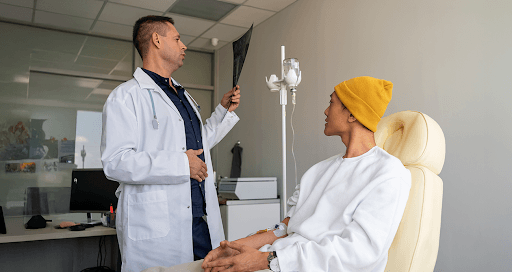
Have you ever experienced waking up suddenly from a deep sleep, struggling to catch your breath? This can be due to Obstructive Sleep Apnea! Obstructive Sleep apnea is one of the most commonly experienced sleep-related breathing disorders. People with Obstructive Sleep Apnea, widely referred to as OSA, tend to have their throat muscles contract and block the oesophagus, blocking the respiratory tract and further affecting the respiratory circuit. This leads to a lack of sleep and hence further complications. It is essential to address this medical condition as prolonged OSA can lead to further health complications.
Obstructive Sleep Apnea is a serious health condition as untreated OSA can lead to further life-threatening complications such as high blood pressure, cardiovascular problems, diabetes, chronic fatigue, liver problems, weakened immune system, depression, and anxiety!
Some initial symptoms of OSA include loud snoring, headaches, and fatigue. If you are suffering from any of these symptoms and suspect that you have OSA, consult with a doctor to get a proper diagnosis. Early medical assistance can help improve your condition and prevent complications related to Obstructive Sleep Apnea.
What is Obstructive Sleep Apnea?
Obstructive Sleep Apnea, commonly called OSA, occurs when your airway gets obstructed during sleep. As you sleep, all the muscles in your body begin to relax. This is a normal part of the sleep cycle and helps your body rest and recover. Naturally, the muscles in your throat relax as a part of this process. However, in the case of a person who experiences OSA, the throat muscles relax extensively, leading the soft tissues to partially or completely block the windpipe. This phenomenon interrupts the respiratory process. The brain detects the lack of oxygen and wakes you up for a short span so your muscles contract and this in turn restores natural breathing. However, these awakenings may go unnoticed as it is only for a short period of time but over a while these continuous disruptions can build up to cause further health complications.
The question arises of how OSA can be differentiated from other natural phenomena such as snoring. Snoring is a natural and harmless occurrence caused by the vibration of the relaxed throat muscles as air passes through them. OSA entails louder and more frequent bouts of snores, causing the person to wake up frequently to restore natural breathing. Other sleep disruptions can occur due to stress, lifestyle, or further medical conditions but none of them typically interrupt your breathing as OSA does.
Symptoms of Obstructive Sleep Apnea
It can be troubling to distinguish the symptoms of Obstructive Sleep Apnea as most of them overlap with commonly occurring phenomena. However, let us take a closer look at the key symptoms of OSA by distinguishing them into day-time and night-time OSA
Night-time Symptoms
- Loud Snoring with uneven pauses
- Restless Sleep
- Choking / Grasping for Air
- Heavy Pauses of Breath
- Dry Mouth
- Sore Throat
- Nocturia
- Excessive sweating
Day-time Symptoms
- Fatigue
- Headaches
- Brain-fog
- Abruptive Mood Changes
- Drowsiness
Additional Symptoms
- Hypertension due to increased blood pressure, brought upon by lack of oxygen during sleep
- Weight gain caused by disruptions in metabolic processes due to unrestful sleep
- Decreased libido due to fatigue and drowsiness.
If you observe any of these symptoms in you or someone you know, please consider getting a consultation as OSA can lead to further health conditions if not treated early.
Causes and Risk Factors
Factors that cause OSA
The root cause of OSA is the obstruction of the upper section windpipe brought about by the extensive relaxation of soft muscle tissues in the throat. However, there are multiple other anatomical and biological elements that can cause OSA and can vary from person to person.
Even a simple move such as sleeping on your back can cause obstruction of the airway by the tongue as well as other muscles which droop down due to gravity. According to a study conducted by the National Library of Medicine and Biotech Information, sleeping on your right side can heavily lessen the occurrence of Obstructive Sleep Apnea. In the case of people who suffer from gastroesophageal reflux disease, sleeping on the left side can prove to be the solution for their OSA. Sleeping on your side is therefore highly recommended to decrease OSA if you are experiencing it. In any sleep position, it is advised to elevate your head and to keep your neck and spine aligned.
A person who suffers from Obesity can have excessive amounts of fats around their neck. This can lead to OSA as the fat around their throat can obstruct their windpipe during sleep. Even enlarged tonsils caused by infections or allergies can block the windpipe and cause OSA. Some people are born with the genetic disadvantage of a narrow airway, they are naturally prone to OSA. Factors such as a smaller chin and receding jaw can also result in obstruction of the windpipe, leading to OSA.
Muscle tones can falter due to old age and this can increase the risk of OSA in golden agers.
Consumption of alcohol can contribute to the extensive relaxation of throat muscles further increasing the likelihood of OSA. Even smoking can cause inflammation of the upper airway, increasing the chances of OSA.
Risk Factors
As we have gone through the factors that can lead to OSA, it is easy to infer that anyone can develop OSA, but certain elements can heighten this medical situation:
- Obesity
- Smoking
- Consumption of Alcohol
- Diabetes
- Asthma
- Nasal Congestion
- Hypertension
- Old-age
- Hereditary Obstructive Sleep Apnea
- Genetical Abnormalities - Narrow Windpipe
- Sleep position
- Irregular sleep
- Hyperthyroidism
- Hormonal imbalances
Some risk factors that cause OSA are inevitable and beyond our power to control, such as hereditary OSA and genetic abnormalities. However, smoking, consumption of alcohol and obesity are something we have power over. Addressing these factors appropriately can significantly lessen the occurrence of Obstructive Sleep Apnea.
Diagnosis of Obstructive Sleep Apnea
Obstructive Sleep Apnea can be diagnosed by a certified healthcare professional such as a Sleep Specialist, Pulmonologist, ENT Specialist, Neurologist or Respiratory Therapist.
Steps in Diagnostic Evaluation
The initial assessment of Obstructive Sleep Apnea includes talking with the medical professional. This discussion can include the patient’s full medical history and other health factors that may contribute to OSA. The medical professional may ask you about your sleeping habits, how often you sleep and your sleep hours, how often you wake up in the middle of the night, and whether you feel satisfied with your sleep in the morning. They may also enquire about your snoring!
The doctor will enquire if you are suffering from any of the day-time symptoms of OSA such as fatigue, drowsiness, or headaches. They will also review your existing medical conditions, if any, to infer a proper diagnosis.
If you have a partner or a parent (in a child’s case) accompanying you to the doctor’s, they can help the doctor in diagnosing OSA by sharing their observations whether you’re snoring extensively or waking up with bouts of breathlessness. Sleep Questionnaire is another method that healthcare professionals use to obtain accurate data from patients, they can infer the severity of the OSA.
Physical Examination for OSA
The physical examination for OSA includes a thorough examination of your neck, throat and mouth. This is to check for any anatomical factors that can be causing the OSA such as a narrow windpipe. Enlarged tonsils, deviated septum or nasal congestion are some other factors that the doctor may be checking for.
Diagnostic tests for OSA
To finalize the diagnosis of Obstructive Sleep Apnea, there are 2 major tests that can be conducted:
Polysomnography: Polysomnography or PSG is an overnight sleep study conducted at a certified sleep center or medical facility where sleep technicians monitor your brain activity, oxygen levels, heart rates, and breathing during your sleep. PSG extracts multiple measurements so as to diagnose OSA. These include EEG, EMG, EOG ECG/EKG, airflow sensors, Respiratory Effort Belts, Pulse oximeters, leg movement sensors and finally video and audio monitors.
Home Sleep Apnea Test: Commonly referred to as HSAT, Home Sleep Apnea Test is a simple test taken at home where you can monitor your breathing and oxygen levels using sensors. The HSAT kit can be obtained from the doctor or the clinic where the diagnosis is taking place. The HSAT KTI will include a thermistor, an oximeter, a chest belt, and other sensors.
Based on the results of these assessments, the healthcare professional will conclude whether or not you are suffering from Obstructive Sleep Apnea and initiate the treatment. Early diagnosis and treatment for OSA can help prevent further health complications.
Difference Between Obstructive and Central Sleep Apnea
CSA or Central Sleep Apnea is a sleep disorder caused by a neurological disconnection between the brain and the body. As you fall asleep, your breathing becomes shallow and much calmer compared to when you are awake and active. However, in people who suffer from CSA, their brains will temporarily stop communicating with the muscles that are responsible for respiratory actions. This means the person suffering from CSA will stop breathing in their sleep and their brain will wake them up to restart normal breathing. These respiratory interruptions can last from several seconds to even a minute and can occur multiple times throughout the sleeping period.
Unlike OSA, which is caused by physical obstruction, CSA is a neurological matter and is an even more serious health condition as it affects and strains the heart, leading to further cardiovascular problems.
Some of the key symptoms of Central Sleep Apnea include:
- Pauses of breath during sleep
- Drowsiness / Daytime sleepiness
- Headaches
- Lack of focus due to poor sleep
- Insomnia
- Fatigue
- Loud snores
- Shallow breathing
CSA is not considered as a medical emergency. However, it can be a serious condition if left untreated, especially for your heart. It is important to consult with a healthcare professional if you suspect you are suffering from Central Sleep Apnea and get proper medical help.
How Common is Obstructive Sleep Apnea?
According to statistics, over 1 billion people suffer from Obstructive Sleep Apnea worldwide. The study inferred that the chance of developing Obstructive Sleep Apnea increases with age, especially in the middle-age bracket. OSA was found to be common in men, nearly double the rates compared to women, but OSA was also found prevalent in women after menopause.
About 1-10% of children suffer from OSA. In younger children, OSA arose from factors such as enlarged tonsils or enlarged adenoids triggered by allergies or infections. Children may not show drowsiness or sleepiness if they are suffering from OSA, they may show signs of hyperactivity and restlessness.
Geographically, regions such as North America and Europe reported higher rates of OSA, this was deduced to arise from their sedentary lifestyle factors, mainly obesity.
Normalisation of poor sleep habits and obesity have become significant factors in the rise of OSA. Especially in the case of middle-aged individuals, who experience reduced muscle tones in addition to increased fat deposits. Limited physical activity in addition to poor sleep and unhealthy food becomes the ultimate gateway for OSA.
In the case of a country like India, Obstructive Sleep Apnea goes undiagnosed due to several major factors. Mainly due to a lack of awareness of OSA and a lack of healthcare resources and personnel. Obesity has become a growing concern in the country and acts as a contributor to the growth of Obstructive Sleep Apnea in the population. Childhood obesity is also linked as a major factor in the case of OSA in younger children in the nation.
Addressing the phenomenon of OSA by addressing obesity is a major way to prevent and manage the medical condition. Targeting weight management and promoting a healthier lifestyle that includes eating healthy and the integration of proper workouts can significantly help in the reduction of OSA.
In conclusion, the earlier you diagnose OSA, the easier it is to treat and bring stoppage to further life-threatening conditions. Public health campaigns regarding Obstructive Sleep Apnea can bring more attention to the condition and help reduce the prevalence of the medical condition.







